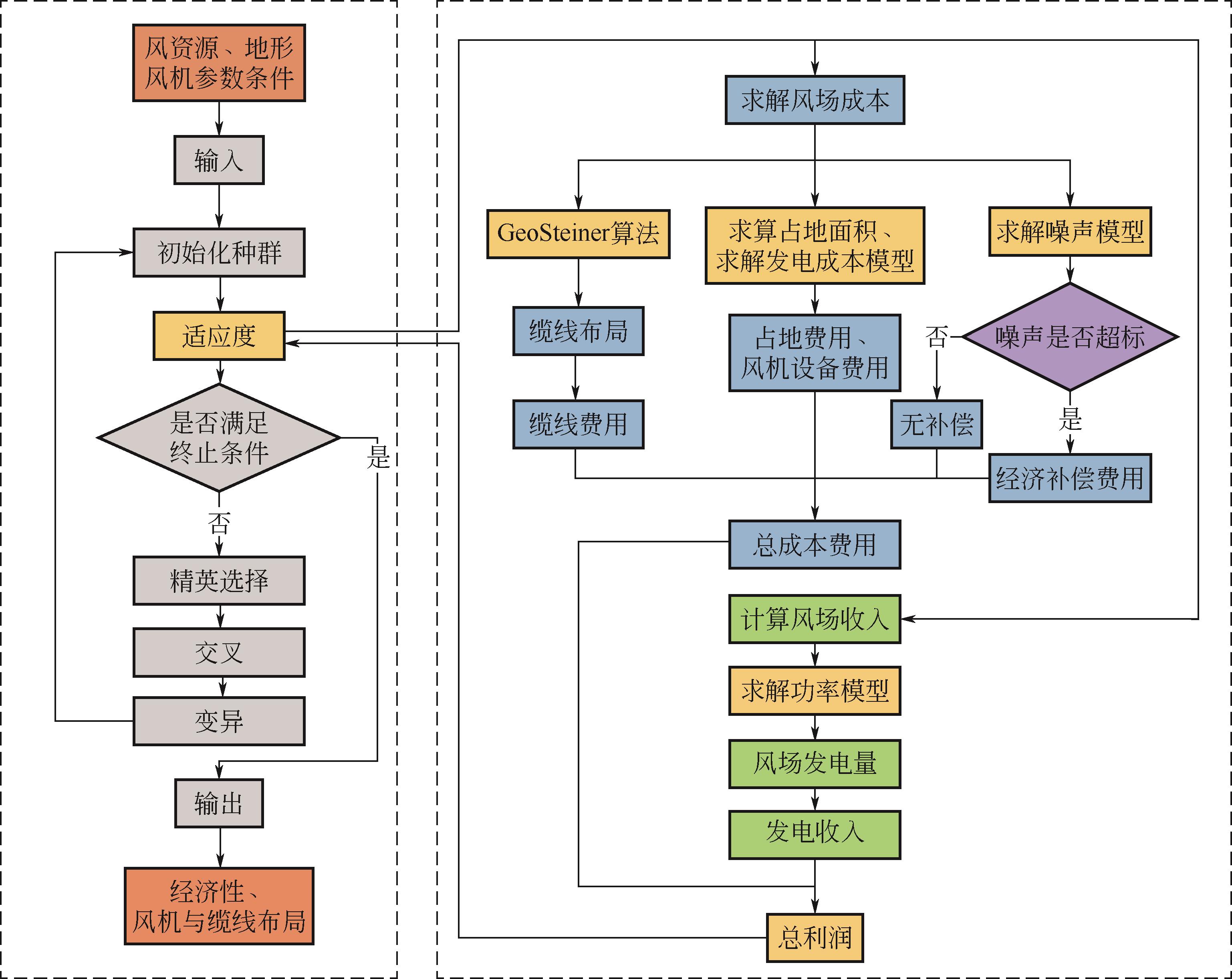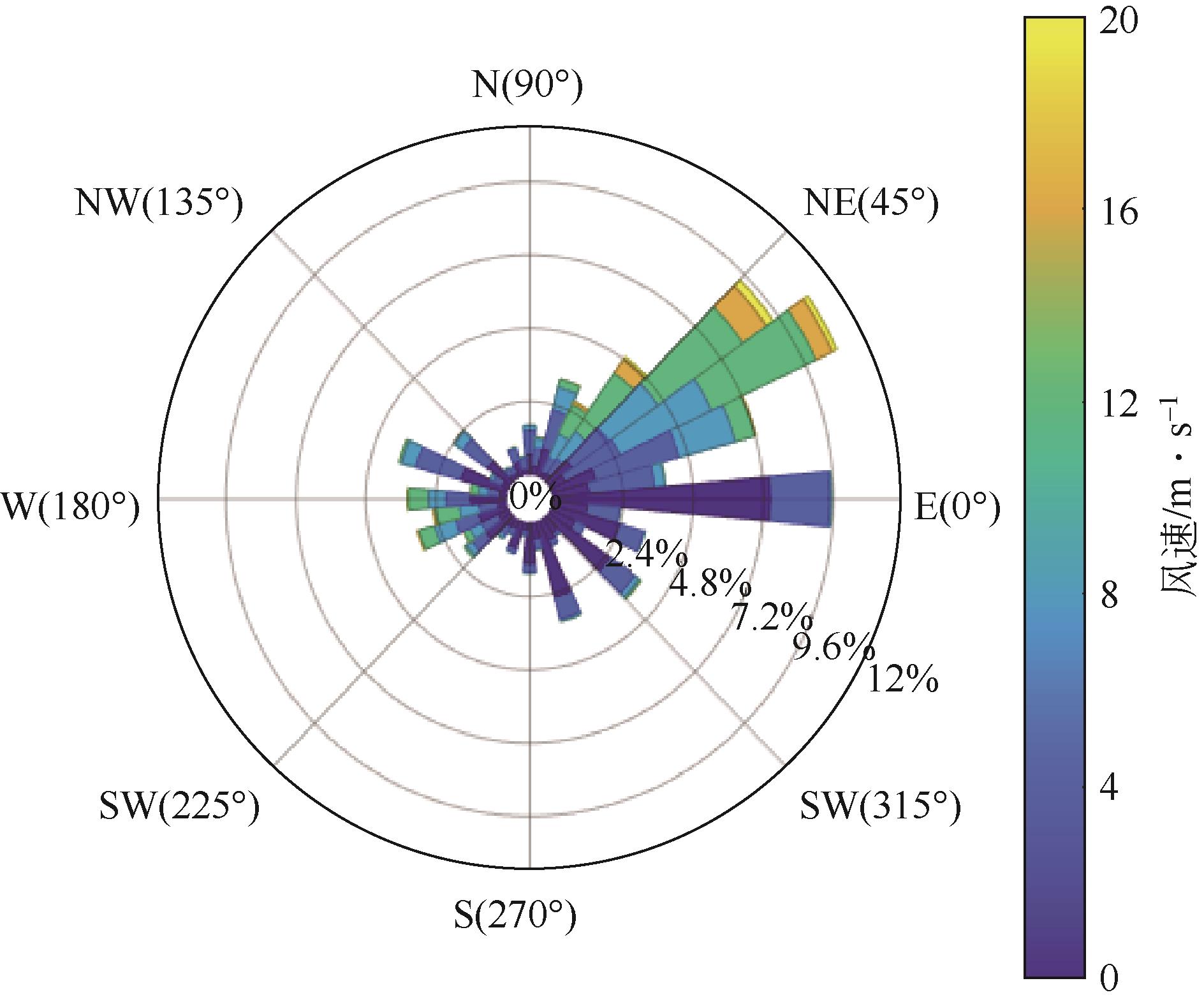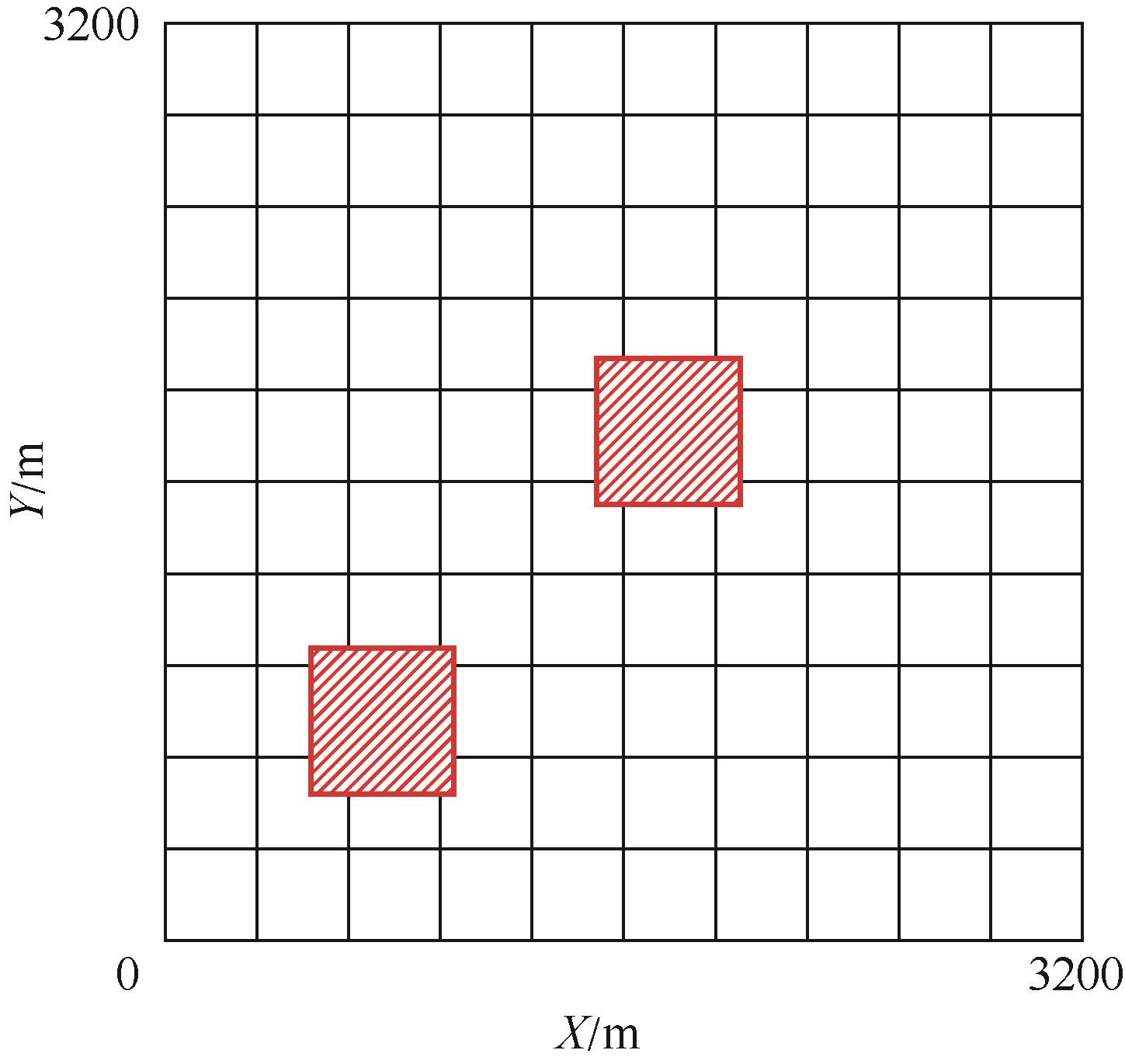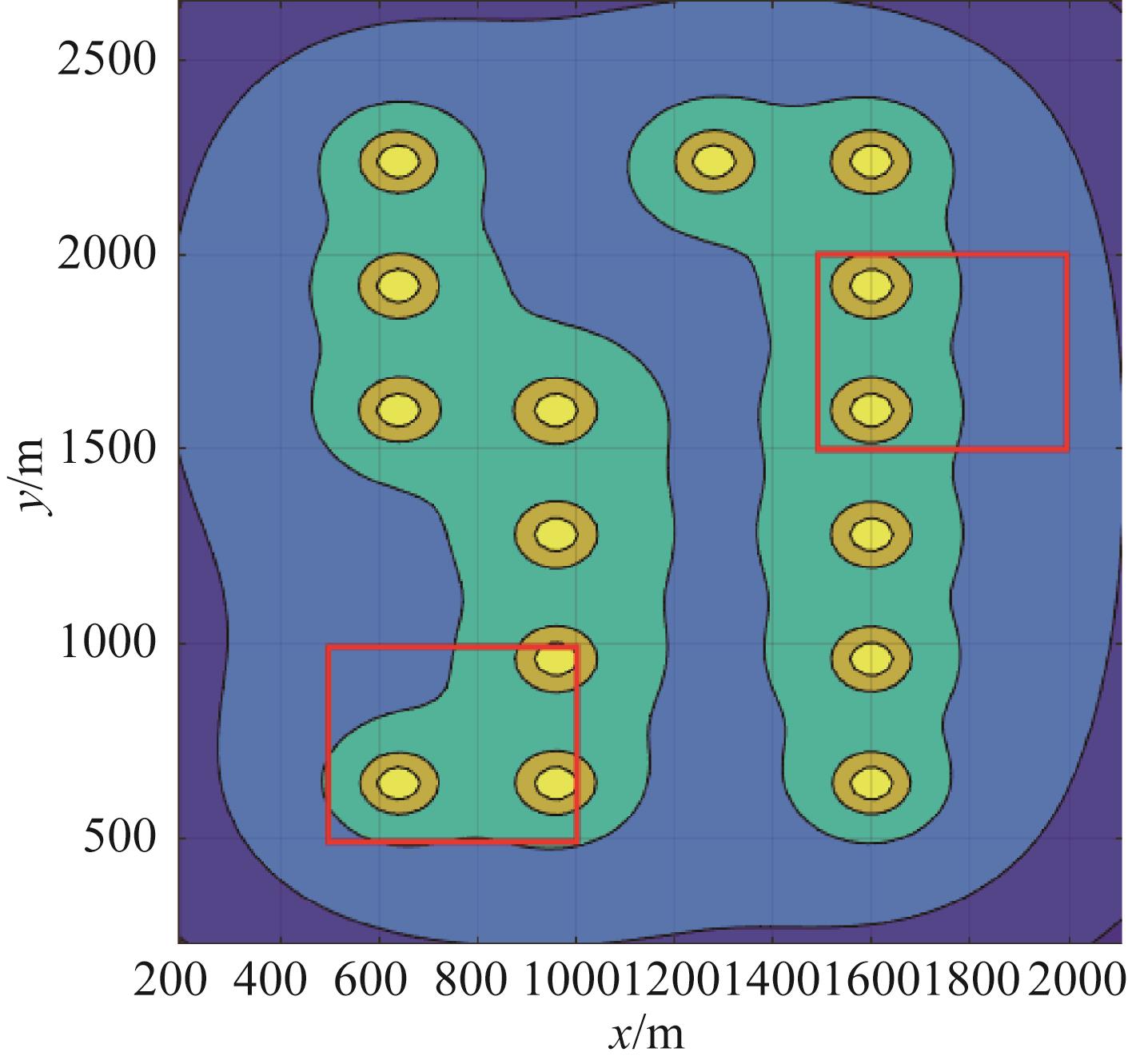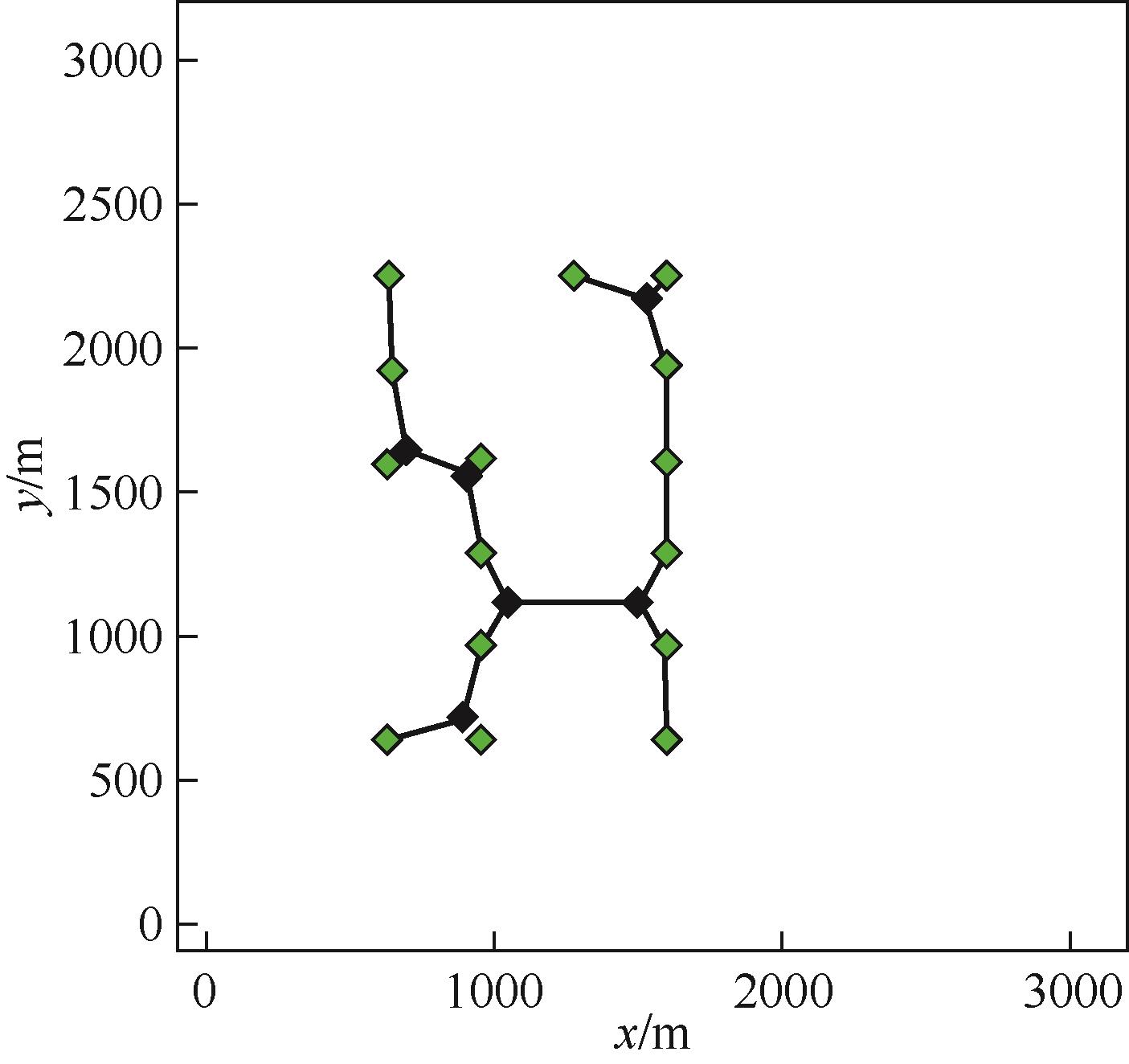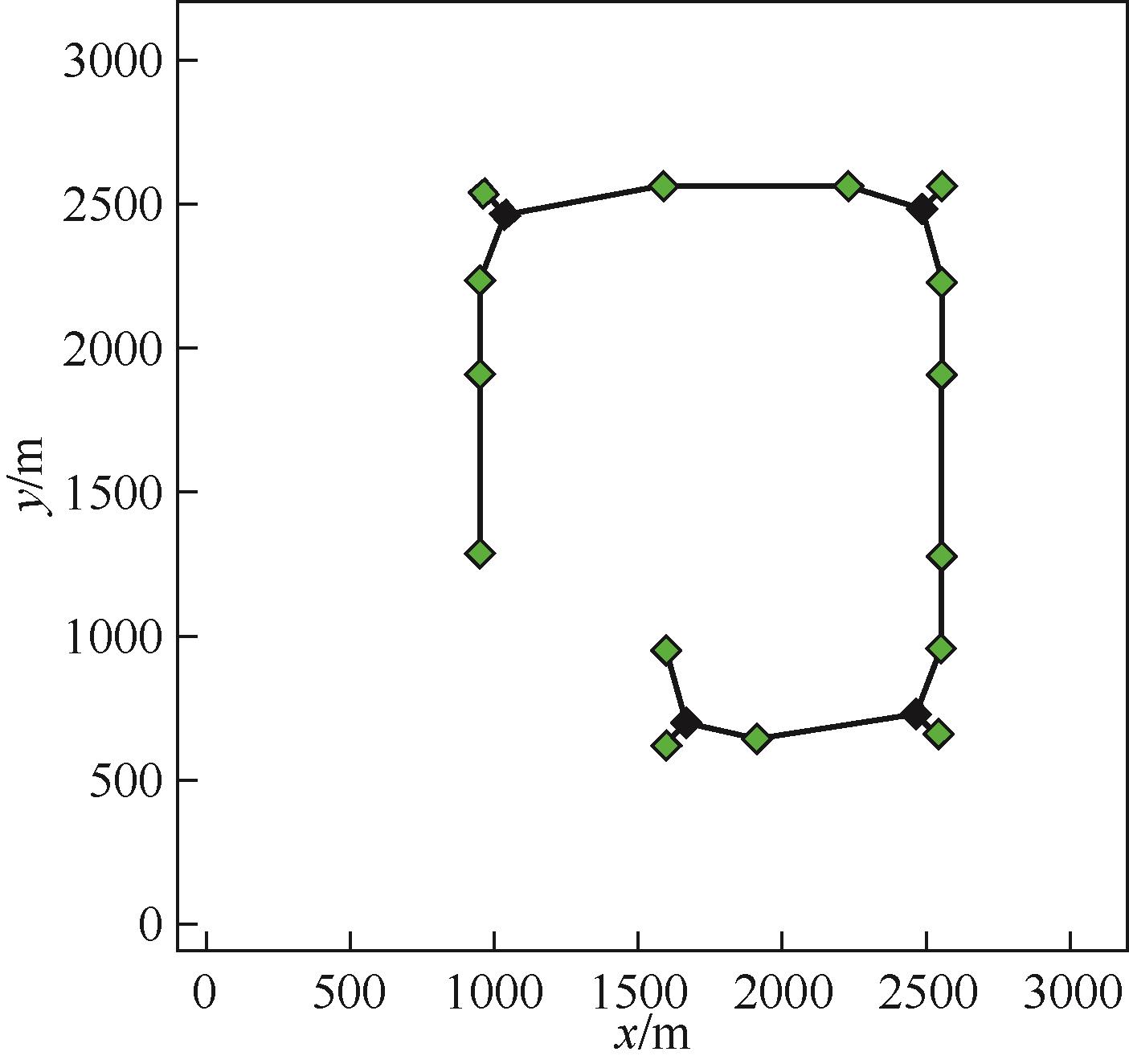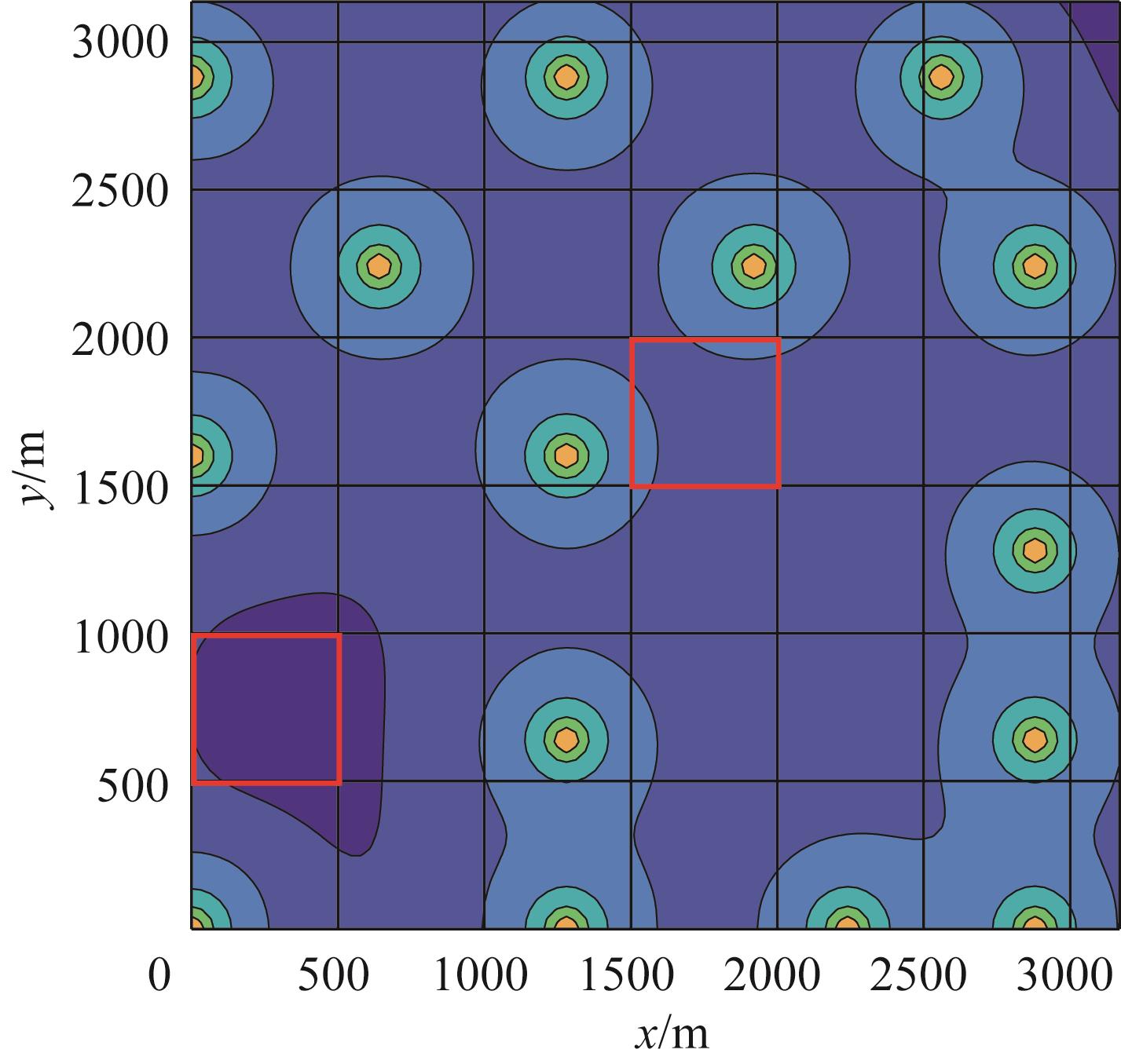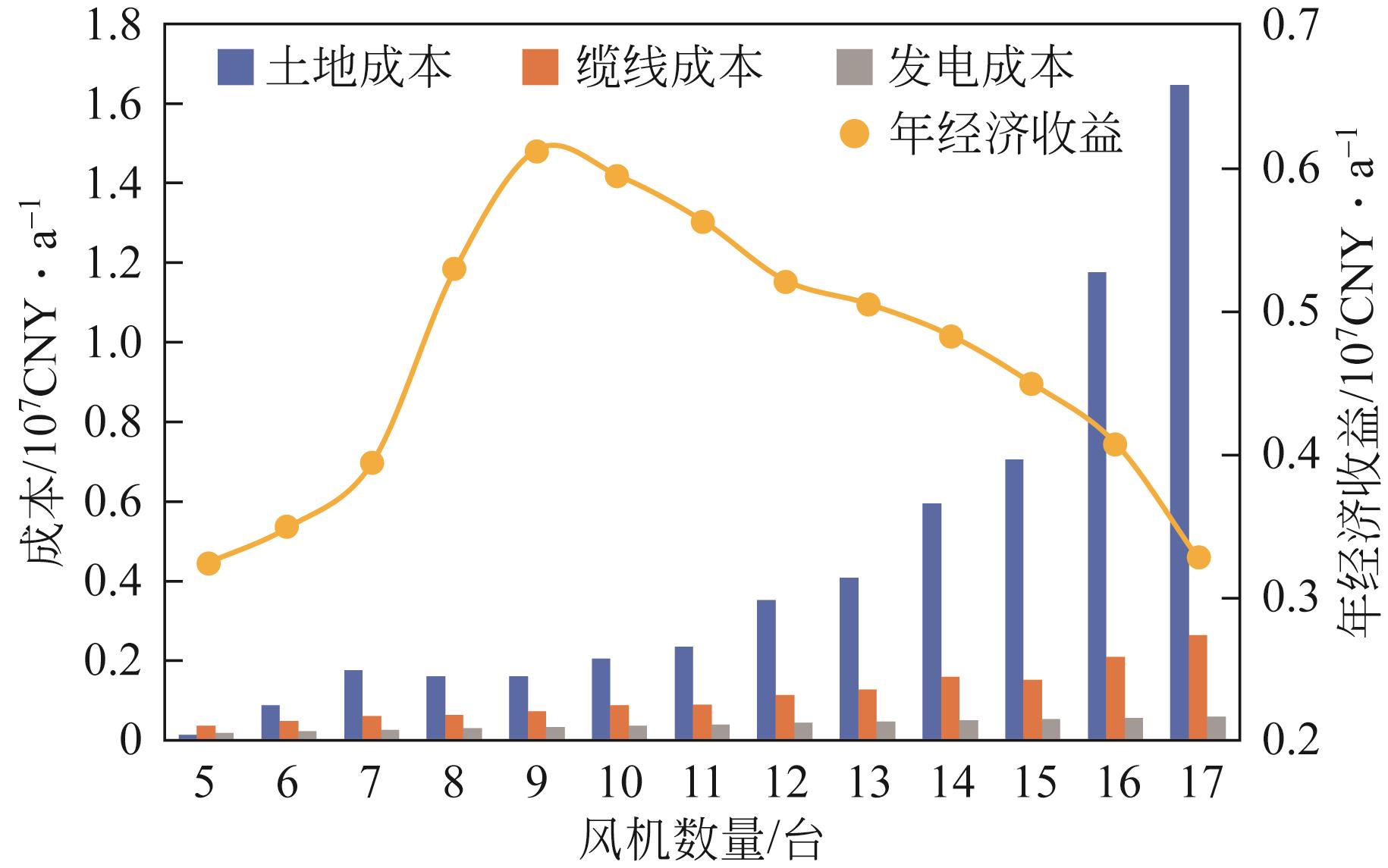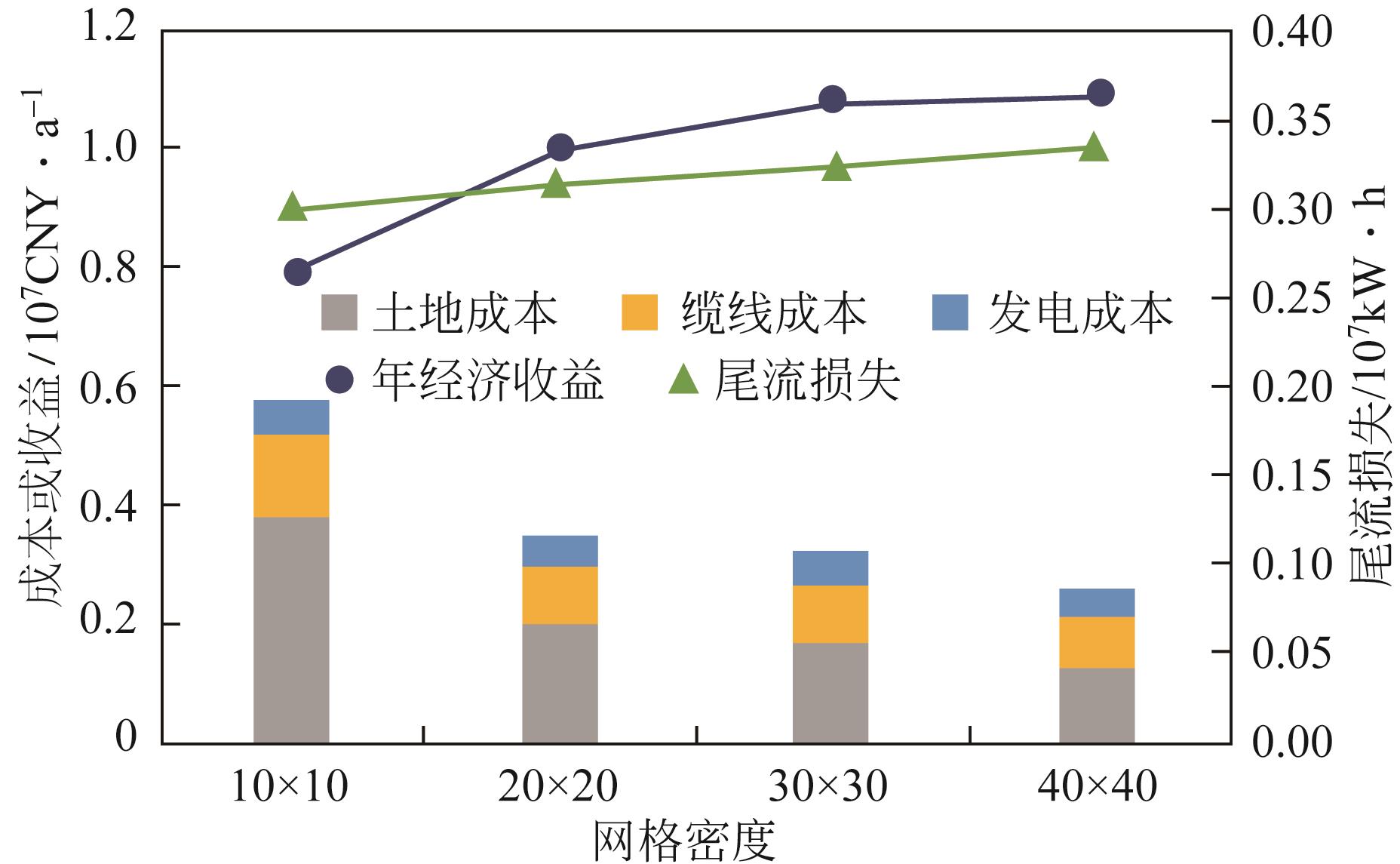Chemical Industry and Engineering Progress ›› 2023, Vol. 42 ›› Issue (7): 3394-3403.DOI: 10.16085/j.issn.1000-6613.2022-1945
• Column: Intelligent chemical equipment and safety • Previous Articles Next Articles
Distributed wind farm layout optimization considering noise constraint
- School of Chemical Engineering and Environment, China University of Petroleum (Beijing), Beijing 102249, China
-
Received:2022-10-19Revised:2023-01-30Online:2023-08-14Published:2023-07-15 -
Contact:WANG Yufei
考虑噪声约束的分布式风场布局优化
- 中国石油大学(北京)化学工程与环境学院,北京 102249
-
通讯作者:王彧斐 -
作者简介:林海(1999—),男,硕士研究生,研究方向为分布式风电。E-mail:2022210607@student.cup.edu.cn。
CLC Number:
Cite this article
LIN Hai, WANG Yufei. Distributed wind farm layout optimization considering noise constraint[J]. Chemical Industry and Engineering Progress, 2023, 42(7): 3394-3403.
林海, 王彧斐. 考虑噪声约束的分布式风场布局优化[J]. 化工进展, 2023, 42(7): 3394-3403.
share this article
Add to citation manager EndNote|Ris|BibTeX
URL: https://hgjz.cip.com.cn/EN/10.16085/j.issn.1000-6613.2022-1945
| 序号 | 角度/(°) | k | c | 概率 |
|---|---|---|---|---|
| 0 | 0~22.5 | 6.7 | 8.6 | 0.2110 |
| 1 | 22.5~45 | 5.7 | 7.6 | 0.2310 |
| 2 | 45~67.5 | 6.3 | 10.9 | 0.0746 |
| 3 | 67.5~90 | 7.3 | 11.9 | 0.0447 |
| 4 | 90~112.5 | 4.1 | 12.6 | 0.0145 |
| 5 | 112.5~135 | 3.1 | 11.6 | 0.0058 |
| 6 | 135~157.5 | 4.3 | 9.7 | 0.0353 |
| 7 | 157.5~180 | 5.3 | 10.7 | 0.0417 |
| 8 | 180~202.5 | 4.3 | 7.6 | 0.0510 |
| 9 | 202.5~225 | 3.3 | 6.6 | 0.0412 |
| 10 | 225~247.5 | 4.7 | 10.6 | 0.0106 |
| 11 | 247.5~270 | 5.7 | 11.6 | 0.0157 |
| 12 | 270~292.5 | 4.5 | 10.7 | 0.0450 |
| 13 | 292.5~315 | 3.5 | 9.7 | 0.0114 |
| 14 | 315~337.5 | 6.7 | 8.6 | 0.0605 |
| 15 | 337.5~360 | 7.7 | 9.6 | 0.1060 |
| 序号 | 角度/(°) | k | c | 概率 |
|---|---|---|---|---|
| 0 | 0~22.5 | 6.7 | 8.6 | 0.2110 |
| 1 | 22.5~45 | 5.7 | 7.6 | 0.2310 |
| 2 | 45~67.5 | 6.3 | 10.9 | 0.0746 |
| 3 | 67.5~90 | 7.3 | 11.9 | 0.0447 |
| 4 | 90~112.5 | 4.1 | 12.6 | 0.0145 |
| 5 | 112.5~135 | 3.1 | 11.6 | 0.0058 |
| 6 | 135~157.5 | 4.3 | 9.7 | 0.0353 |
| 7 | 157.5~180 | 5.3 | 10.7 | 0.0417 |
| 8 | 180~202.5 | 4.3 | 7.6 | 0.0510 |
| 9 | 202.5~225 | 3.3 | 6.6 | 0.0412 |
| 10 | 225~247.5 | 4.7 | 10.6 | 0.0106 |
| 11 | 247.5~270 | 5.7 | 11.6 | 0.0157 |
| 12 | 270~292.5 | 4.5 | 10.7 | 0.0450 |
| 13 | 292.5~315 | 3.5 | 9.7 | 0.0114 |
| 14 | 315~337.5 | 6.7 | 8.6 | 0.0605 |
| 15 | 337.5~360 | 7.7 | 9.6 | 0.1060 |
| 噪声约束 | 情景1 | 情景2 | 情景3 | 情景4 |
|---|---|---|---|---|
| 不含约束 | 含约束 | 不含约束 | 含约束 | |
| AEB/106CNY | 6.90 | 7.90 | -11.1 | -12.7 |
| APB/106CNY | 12.3 | 13.7 | 15.7 | 15.6 |
| Cnoise/106CNY | (115.0) | 0.01 | (91.1) | 1.60 |
| Cenergy/106CNY | 0.53 | 0.53 | 0.53 | 0.53 |
| Ccable/106CNY | 1.33 | 1.42 | 3.26 | 3.26 |
| Cland/106CNY | 3.53 | 3.82 | 22.9 | 22.9 |
| TAC/106CNY | 5.40 | 5.79 | 26.7 | 28.3 |
| 噪声约束 | 情景1 | 情景2 | 情景3 | 情景4 |
|---|---|---|---|---|
| 不含约束 | 含约束 | 不含约束 | 含约束 | |
| AEB/106CNY | 6.90 | 7.90 | -11.1 | -12.7 |
| APB/106CNY | 12.3 | 13.7 | 15.7 | 15.6 |
| Cnoise/106CNY | (115.0) | 0.01 | (91.1) | 1.60 |
| Cenergy/106CNY | 0.53 | 0.53 | 0.53 | 0.53 |
| Ccable/106CNY | 1.33 | 1.42 | 3.26 | 3.26 |
| Cland/106CNY | 3.53 | 3.82 | 22.9 | 22.9 |
| TAC/106CNY | 5.40 | 5.79 | 26.7 | 28.3 |
| 尾流及损失 | 情景1 | 情景2 | 情景3 | 情景4 |
|---|---|---|---|---|
| Preal/107kW·h | 1.64 | 1.83 | 2.09 | 2.08 |
| Pideal/107kW·h | 2.13 | 2.13 | 2.13 | 2.13 |
| Loss/107kW·h | 0.49 | 0.30 | 0.04 | 0.05 |
| 尾流及损失 | 情景1 | 情景2 | 情景3 | 情景4 |
|---|---|---|---|---|
| Preal/107kW·h | 1.64 | 1.83 | 2.09 | 2.08 |
| Pideal/107kW·h | 2.13 | 2.13 | 2.13 | 2.13 |
| Loss/107kW·h | 0.49 | 0.30 | 0.04 | 0.05 |
| 1 | International Renewable Energy Agency. Renewable Capacity Statistics 2022[EB/OL]. . |
| 2 | ŽARKOVIĆ S D, SHAYESTEH E, HILBER P. Onshore wind farm—Reliability centered cable routing[J]. Electric Power Systems Research, 2021, 196: 107201. |
| 3 | FISCHETTI M, PISINGER D. Mathematical optimization and algorithms for offshore wind farm design: An overview[J]. Business & Information Systems Engineering, 2019, 61(4): 469-485. |
| 4 | WINTER P, ZACHARIASEN M. Euclidean steiner minimum trees: An improved exact algorithm[J]. Networks, 1997, 30(3): 149-166. |
| 5 | OLAOFE Z O. Review of energy systems deployment and development of offshore wind energy resource map at the coastal regions of Africa[J]. Energy, 2018, 161: 1096-1114. |
| 6 | ASGHAR A B, LIU Xiaodong. Estimation of wind speed probability distribution and wind energy potential using adaptive neuro-fuzzy methodology[J]. Neurocomputing, 2018, 287: 58-67. |
| 7 | JÄGER T, MCKENNA R, FICHTNER W. The feasible onshore wind energy potential in Baden-Württemberg: A bottom-up methodology considering socio-economic constraints[J]. Renewable Energy, 2016, 96: 662-675. |
| 8 | SHAKOOR R, HASSAN M Y, RAHEEM A, et al. Wake effect modeling: A review of wind farm layout optimization using Jensen׳s model[J]. Renewable and Sustainable Energy Reviews, 2016, 58: 1048-1059. |
| 9 | GAO Xiaoxia, YANG Hongxing, LU Lin. Optimization of wind turbine layout position in a wind farm using a newly-developed two-dimensional wake model[J]. Applied Energy, 2016, 174: 192-200. |
| 10 | SUN Haiying, YANG Hongxing. Comparative study on a newly-developed three-dimensional wind turbine wake model[J]. Energy Procedia, 2019, 158: 148-153. |
| 11 | SUN Haiying, YANG Hongxing, GAO Xiaoxia. Investigation into spacing restriction and layout optimization of wind farm with multiple types of wind turbines[J]. Energy, 2019, 168: 637-650. |
| 12 | WANG Longyan, TAN A C C, CHOLETTE M, et al. Comparison of the effectiveness of analytical wake models for wind farm with constant and variable hub heights[J]. Energy Conversion and Management, 2016, 124: 189-202. |
| 13 | TAO Siyu, XU Qingshan, FEIJÓO A, et al. Wind farm layout optimization with a three-dimensional Gaussian wake model[J]. Renewable Energy, 2020, 159: 553-569. |
| 14 | RODRIGUES S, BAUER P, BOSMAN P A N. Multi-objective optimization of wind farm layouts - Complexity, constraint handling and scalability[J]. Renewable and Sustainable Energy Reviews, 2016, 65: 587-609. |
| 15 | AMARAL L, CASTRO R. Offshore wind farm layout optimization regarding wake effects and electrical losses[J]. Engineering Applications of Artificial Intelligence, 2017, 60: 26-34. |
| 16 | GONZALEZ-RODRIGUEZ A G, BURGOS-PAYAN M, RIQUELME-SANTOS J, et al. Reducing computational effort in the calculation of annual energy produced in wind farms[J]. Renewable and Sustainable Energy Reviews, 2015, 43: 656-665. |
| 17 | BEŞKIRLI M, KOÇ İ, HAKLI H, et al. A new optimization algorithm for solving wind turbine placement problem: Binary artificial algae algorithm[J]. Renewable Energy, 2018, 121: 301-308. |
| 18 | DHUNNY A Z, ALLAM Z, LOBINE D, et al. Sustainable renewable energy planning and wind farming optimization from a biodiversity perspective[J]. Energy, 2019, 185: 1282-1297. |
| 19 | WANG Longyan, CHOLETTE M E, TAN A C C, et al. A computationally-efficient layout optimization method for real wind farms considering altitude variations[J]. Energy, 2017, 132: 147-159. |
| 20 | PAUL S, RATHER Z H. A novel approach for optimal cabling and determination of suitable topology of MTDC connected offshore wind farm cluster[J]. Electric Power Systems Research, 2022, 208: 107877. |
| 21 | WU Yan, XIA Tianqi, WANG Yufei, et al. A synchronization methodology for 3D offshore wind farm layout optimization with multi-type wind turbines and obstacle-avoiding cable network[J]. Renewable Energy, 2022, 185: 302-320. |
| 22 | ZHU Weijun, HEILSKOV N, SHEN Wenzhong, et al. Modeling of aerodynamically generated noise from wind turbines[J]. Journal of Solar Energy Engineering, 2005, 127(4): 517-528. |
| 23 | SHEN Wenzhong, ZHU Weijun, BARLAS E, et al. Advanced flow and noise simulation method for wind farm assessment in complex terrain[J]. Renewable Energy, 2019, 143: 1812-1825. |
| 24 | ZHU Weijun, SHEN Wenzhong, BARLAS E, et al. Wind turbine noise generation and propagation modeling at DTU Wind Energy: A review[J]. Renewable and Sustainable Energy Reviews, 2018, 88: 133-150. |
| 25 | SHALTOUT M L, YAN Zeyu, PALEJIYA D, et al. Tradeoff analysis of energy harvesting and noise emission for distributed wind turbines[J]. Sustainable Energy Technologies and Assessments, 2015, 10: 12-21. |
| 26 | WU Xiawei, HU Weihao, HUANG Qi, et al. Optimal power dispatch strategy of onshore wind farms considering environmental impact[J]. International Journal of Electrical Power & Energy Systems, 2020, 116: 105548. |
| 27 | WU Xinghong, WU Yan, WANG Yufei, et al. A multi-periods offshore wind farm optimization method for supplying energy in a natural gas hydrates exploitation platform[J]. Journal of Cleaner Production, 2021, 316: 128238. |
| 28 | CHEN K, SONG M X, ZHANG X, et al. Wind turbine layout optimization with multiple hub height wind turbines using greedy algorithm[J]. Renewable Energy, 2016, 96: 676-686. |
| 29 | LACKNER M A, ELKINTON C N. An analytical framework for offshore wind farm layout optimization[J]. Wind Engineering, 2007, 31(1): 17-31. |
| 30 | 吴艳. 基于网络拓扑优化的设施布局智能设计方法[D]. 西安: 西安交通大学, 2021. |
| WU Yan. Intelligent design methodology of facility layout based on network topology optimization[D]. Xi’an: Xi’an Jiaotong University, 2021. | |
| 31 | HUBBARD H H, SHEPHERD K P. Aeroacoustics of large wind turbines[J]. The Journal of the Acoustical Society of America, 1991, 89(6): 2495-2508. |
| 32 | EVANS T, COOPER J. Comparison of predicted and measured wind farm noise levels and implications for assessments of new wind farms[C]// Proceedings of ACOUSTICS 2011, 2011 |
| 33 | HUBBARD H H, SHEPHERD K P. Wind turbine acoustics[M]. NASA, 1991. |
| 34 | WU Xiawei, HU Weihao, HUANG Qi, et al. Optimizing the layout of onshore wind farms to minimize noise[J]. Applied Energy, 2020, 267: 114896. |
| 35 | WU Yan, CUI Ziyuan, LIN Hai, et al. An optimization method for shale gas gathering system—Consideration of reliability enhancement under earthquake-related uncertainties[J]. Petroleum Science, 2022, 19(5): 2431-2447. |
| 36 | WU Yan, ZHANG Shuai, WANG Ruiqi, et al. A design methodology for wind farm layout considering cable routing and economic benefit based on genetic algorithm and GeoSteiner[J]. Renewable Energy, 2020, 146: 687-698. |
| 37 | National Centers for Environmental Information. Hourly/Sub-Hourly Observational Data Map of National Centers for Environmental Information[EB/OL]. . |
| [1] | WANG Zhengkun, LI Sifang. Green synthesis of gemini surfactant decyne diol [J]. Chemical Industry and Engineering Progress, 2023, 42(S1): 400-410. |
| [2] | LI Mengyuan, GUO Fan, LI Qunsheng. Simulation and optimization of the third and fourth distillation columns in the recovery section of polyvinyl alcohol production [J]. Chemical Industry and Engineering Progress, 2023, 42(S1): 113-123. |
| [3] | ZHANG Ruijie, LIU Zhilin, WANG Junwen, ZHANG Wei, HAN Deqiu, LI Ting, ZOU Xiong. On-line dynamic simulation and optimization of water-cooled cascade refrigeration system [J]. Chemical Industry and Engineering Progress, 2023, 42(S1): 124-132. |
| [4] | WANG Fu'an. Consumption and emission reduction of the reactor of 300kt/a propylene oxide process [J]. Chemical Industry and Engineering Progress, 2023, 42(S1): 213-218. |
| [5] | LI Chunli, HAN Xiaoguang, LIU Jiapeng, WANG Yatao, WANG Chenxi, WANG Honghai, PENG Sheng. Research progress of liquid distributors in packed columns [J]. Chemical Industry and Engineering Progress, 2023, 42(9): 4479-4495. |
| [6] | WANG Junjie, PAN Yanqiu, NIU Yabin, YU Lu. Molecular level catalytic reforming model construction and application [J]. Chemical Industry and Engineering Progress, 2023, 42(7): 3404-3412. |
| [7] | LI Haidong, YANG Yuankun, GUO Shushu, WANG Benjin, YUE Tingting, FU Kaibin, WANG Zhe, HE Shouqin, YAO Jun, CHEN Shu. Effect of carbonization and calcination temperature on As(Ⅲ) removal performance of plant-based Fe-C microelectrolytic materials [J]. Chemical Industry and Engineering Progress, 2023, 42(7): 3652-3663. |
| [8] | HOU Dianbao, HE Maoyong, CHEN Yugang, YANG Haiyun, LI Haimin. Application analysis of resource allocation optimization and circular economy in development and utilization of potassium resources [J]. Chemical Industry and Engineering Progress, 2023, 42(6): 3197-3208. |
| [9] | GU Shiya, DONG Yachao, LIU Linlin, ZHANG Lei, ZHUANG Yu, DU Jian. Design and optimization of pipeline system for carbon capture considering intermediate nodes [J]. Chemical Industry and Engineering Progress, 2023, 42(6): 2799-2808. |
| [10] | LING Shan, LIU Juming, ZHANG Qiancheng, LI Yan. Research progress on simulated moving bed separation process and its optimization methods [J]. Chemical Industry and Engineering Progress, 2023, 42(5): 2233-2244. |
| [11] | ZHU Hao, LIU Hanfei, GAO Yuan, BAI Rongrong, NI Songbo, HUANG Yiping, LI Qingtong, LI Xiaodong, HAN Weiqing. Parameter optimization of jet aeration in catalytic ozonation system and analysis of stage oxidation of phenol [J]. Chemical Industry and Engineering Progress, 2023, 42(5): 2717-2723. |
| [12] | WANG Dong, YU Pinhua, CHEN Bin, XIAO Ang, CHEN Feng, JIANG Yangyang. Energy saving optimization of cyclohexane three-effect distillation in cyclohexanone production [J]. Chemical Industry and Engineering Progress, 2023, 42(5): 2245-2251. |
| [13] | LIU Guangping, LU Zhenneng, GONG Yulie. Dynamic response and disturbance optimization of high temperature heat pump steam systems [J]. Chemical Industry and Engineering Progress, 2023, 42(4): 1719-1727. |
| [14] | MA Runmei, YANG Haichao, LI Zhengda, LI Shuangxi, ZHAO Xiang, ZHANG Guoqing. Influence analysis of coating on deformation and frictional wear of mechanical seal end for high-speed bearing cavity [J]. Chemical Industry and Engineering Progress, 2023, 42(4): 1688-1697. |
| [15] | WU Heng, LI Yinlong, YAN Gang, XIONG Tong, ZHANG Hao, TAO Kui. Vapor-liquid separation technology in refrigeration/heat pump systems [J]. Chemical Industry and Engineering Progress, 2023, 42(3): 1129-1142. |
| Viewed | ||||||
|
Full text |
|
|||||
|
Abstract |
|
|||||


